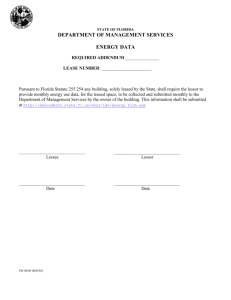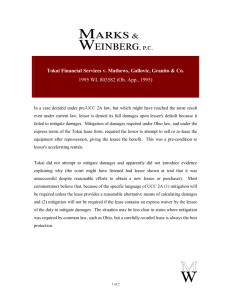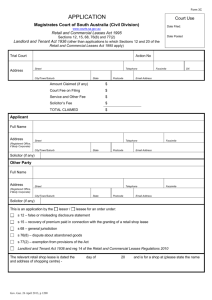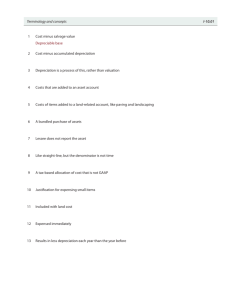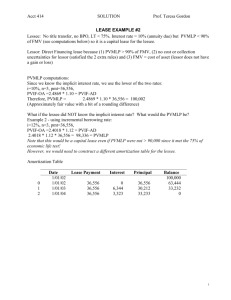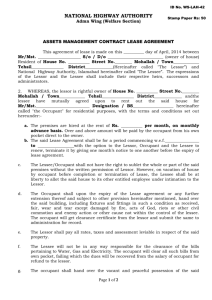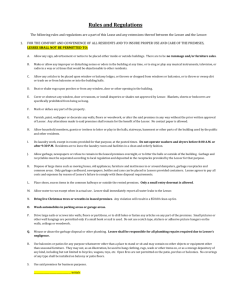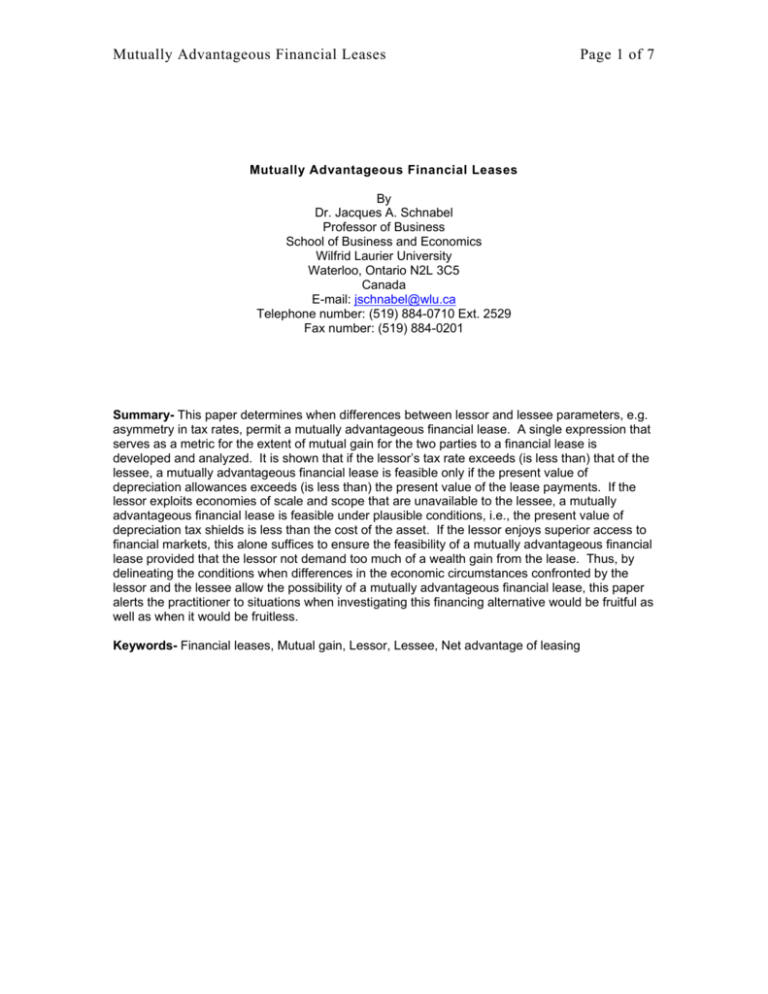
Mutually Advantageous Financial Leases
Page 1 of 7
Mutually Advantageous Financial Leases
By
Dr. Jacques A. Schnabel
Professor of Business
School of Business and Economics
Wilfrid Laurier University
Waterloo, Ontario N2L 3C5
Canada
E-mail: jschnabel@wlu.ca
Telephone number: (519) 884-0710 Ext. 2529
Fax number: (519) 884-0201
Summary- This paper determines when differences between lessor and lessee parameters, e.g.
asymmetry in tax rates, permit a mutually advantageous financial lease. A single expression that
serves as a metric for the extent of mutual gain for the two parties to a financial lease is
developed and analyzed. It is shown that if the lessor’s tax rate exceeds (is less than) that of the
lessee, a mutually advantageous financial lease is feasible only if the present value of
depreciation allowances exceeds (is less than) the present value of the lease payments. If the
lessor exploits economies of scale and scope that are unavailable to the lessee, a mutually
advantageous financial lease is feasible under plausible conditions, i.e., the present value of
depreciation tax shields is less than the cost of the asset. If the lessor enjoys superior access to
financial markets, this alone suffices to ensure the feasibility of a mutually advantageous financial
lease provided that the lessor not demand too much of a wealth gain from the lease. Thus, by
delineating the conditions when differences in the economic circumstances confronted by the
lessor and the lessee allow the possibility of a mutually advantageous financial lease, this paper
alerts the practitioner to situations when investigating this financing alternative would be fruitful as
well as when it would be fruitless.
Keywords- Financial leases, Mutual gain, Lessor, Lessee, Net advantage of leasing
Mutually Advantageous Financial Leases
Page 2 of 7
Mutually Advantageous Financial Leases
1. Introduction
In both the textbook as well as the journal literature on financial leases, the
topic is typically broached by first adopting the perspective of one party to the contract,
say the lessee, and then shifting to the perspective of the second party, say the lessor.
Expressions for the wealth gain each entity garners are developed, usually denoted the
party’s Net Advantage of Leasing or, more succinctly, NAL. These two expressions are
then compared in an attempt to delineate situations where mutual gain for the two
parties is possible, i.e., where both expressions for NAL are positive. Among others,
this approach is exemplified in the textbook literature by Ross et al. (2005) and Brealey
et al. (2003) and in the journal literature by Lewellen et al. (1976).
This paper follows in this tradition of emphasizing the mutuality of advantage to
ensure the viability of a financial lease, i.e., neither party acquiesces to self-harm.
Where it departs from the customary approach is in the latter’s use of a two-formula
paradigm. Here a single formula that serves as the sole metric for the lease’s
attractiveness to both lessor and lessee is developed. A positive value of the formula
signals a mutually beneficial lease. As the single expression contains distinct
parameters that pertain to each of the two parties, the task of searching for situations of
mutual gain is facilitated. As will be demonstrated later, this approach becomes
especially useful when analyzing the case of tax asymmetry, i.e. where the lessor’s tax
rate differs from that of the lessee.
The next section sets out the model, culminating in the single expression for mutual
wealth gain that is the focus of this paper. The next three sections consider seriatim situations of
tax differentials, lessor economies of scale and scope, and finally superior lessor access to
financial markets.
2. Model Development
Define C as the cost of acquiring the leased asset, S as the salvage value realized on the
asset, and T as the tax rate. The subscript OR refers to the lessor whereas the subscript EE
refers to the lessee. Thus, for example, COR is the lost of the leased asset to the lessor whereas
TEE is the lessee’s tax rate.
Since lease contracts typically stipulate that payments are due at the start of each period,
the lease contract constitutes an annuity due. In this connection, define PVIFAD(K,n) as the
present value interest factor of an annuity due with a term of n years and where K is the discount
rate. To simplify the presentation, the customary assumption of annual lease payments is
adopted. The length of the lease period is n years whereas the economic life of the asset is m
years.
Define a t as the percent of the asset’s original cost that is claimed as depreciation for
tax purposes in year t and m as the depreciable life of the asset. This formulation has the
flexibility to accommodate a wide spectrum of tax depreciation methods. When applied to a
three-year asset in the context of the U.S. Modified Accelerated Cost Recovery System, the
depreciation allowance schedule is as follows: a1 = 33.33%, a 2 = 44.44%, a3 = 14.82%,
a 4 = 7.41% , and m = 4 as explained in Ross et al. (1998). When applied to an asset with a
depreciation rate of 30% in the context of the Canadian System of Capital Cost Allowances, the
depreciation allowance schedule is as follows: a1 = 15%, a 2 = 25.5%, a3 = 17.85%, … and m
equals infinity as explained in Ross et al. (2005).
Should investment tax credits be available, the sum of the a t terms over the depreciable
life of the asset will exceed 100%. In addition, if the investment tax credit is immediately available
at the time of asset purchased, then the term a 0 will exceed 0. So as not to preclude the latter
possibility, the summation of the a t terms starts at 0 and the summation of these terms is not
restricted to equal 1.
Mutually Advantageous Financial Leases
Page 3 of 7
Define KTOR as the lessor’s target post-tax rate of return on the lease contract. For the
contract to be lessor wealth enhancing, clearly KTOR must exceed the lessor’s cost of capital.
The lessor sets the annual lease payment, L, to satisfy the following requirement.
m
C OR = L(1 − TOR ) PVIFA( KTOR , n) + TOR C OR ∑
t =0
at
(1 + KTOR )
t
+
S OR
(1 + KTOR )m
(1)
Observe that on the RHS (right-hand side) of equation (1), the first term is the present value of
the post-tax lease payments, the second term represents the present value of the depreciation
tax shields, inclusive of any possible investment tax credit, obtained by the lessor, and the third
term is the present value of the leased asset’s salvage value realized by the lessor.
The Net Advantage of Leasing, or NAL, to the lessee may be depicted as follows.
m
NAL = C EE − L(1 − TEE ) PVIFA( K EE , n) − TEE C EE ∑
t =0
at
(1 + K EE )
t
−
S EE
(1 + K EE )m
(2)
The RHS terms of equation (2) are respectively, the cost of the leased asset that is
saved by the lessee, the present value of the after-tax lease payments made by the
lessee, the present value of the depreciation tax shields and the present value of the
leased asset’s salvage value, both of which are lost by the lessee.
As indicated earlier, much of the existing literature essentially involves a comparison of
equations (1) and (2), attempting to determine situations where differences between lessor and
lessee parameters lead to the possibility of a lease contract that is mutually beneficial. The tack
taken in this paper is to embed equation (1) in equation (2) and then enquire under what
conditions NAL is positive. As KTOR exceeds the lessor’s cost of capital, the positivity of NAL
ensures that the lease is beneficial to both parties. Stated another way, if the lessor sets a lease
rate that satisfies its rate of return requirement and is therefore beneficial to it, will the lease be
likewise beneficial to the lessee? More importantly, what differences in lessor and lessee
parameters would ensure such an eventuality?
First determining the formula for L implied by equation (1), then substituting the resulting
formula into equation (2) and subsequently simplifying, the following equation is derived.
NAL = (C EE − C OR ) + L [PVIFAD ( KT OR , n ) − PVIFAD ( K EE , n ) ]
m
m
⎤
⎡
⎤
⎡
at
at
(
,
)
PVIFAD
KT
n
T
C
−
− PVIFAD( K EE , n)⎥
+ TOR ⎢C OR ∑
−
⎥ EE ⎢ EE ∑
OR
t
t
t = 0 (1 + KTOR )
t = 0 (1 + K EE )
⎥⎦
⎢⎣
⎦
⎣
⎤
⎡
S OR
S EE
+⎢
−
⎥
m
(1 + K EE )m ⎦⎥
⎣⎢ (1 + KTOR )
(3)
Given the numerous parameters present in equation (3), conditions that ensure that NAL exceed
zero are difficult to determine analytically. This task is facilitated by sequentially assuming, in the
next section, that the lessor and lessee differ solely in terms of their tax rates. In the subsequent
section, it is assumed that the lessor and lessee differ solely in terms of the asset’s acquisition
cost and salvage value. In the penultimate section of this paper, it is assumed that the lessor’s
target rate of return differs from the lessee’s cost of capital, with all the other parameters for both
parties equaling common values. This ceteris paribus exercise allows the examination of how tax
asymmetry, economies of scale and scope available to the lessor but not to the lessee, and the
lessor’s superior access to financial markets compared to that of the lessee render feasible a
mutually beneficial lease.
Mutually Advantageous Financial Leases
Page 4 of 7
3. Tax Asymmetry
In this section, it is assumed that while C OR = C EE , equaling a common value of C,
S OR = S EE , equaling a common value of S, and KTOR = K EE , equaling a common value of K,
TOR is not equal to TEE . Introducing these restrictions into equation (3), the following is
obtained.
⎡ m
⎤
at
− L[PVIFAD( K , n)]⎥
NAL = (TOR − TEE )⎢C ∑
t
⎣ t =0 (1 + K )
⎦
(4)
Observe that the RHS of equation (4) is the product of two factors. The first factor is the amount
by which the lessor’s tax rate exceeds that of the lessee, whereas the second factor is the
amount by which the present value of depreciation allowances inclusive of any investment tax
credit exceeds the present value of the lease payments.
If the lessor’s tax rate exceeds that of the lessee, then the lease will be mutually
beneficial only if the second factor is positive, i.e., the present value of the depreciation
allowances exceeds the present value of the lease payments. The latter requirement is crucial
and it is one that is uniformly overlooked in the existing literature.
For example, Ross et al. (2005) articulate the following argument: “The basic logic
behind structuring a leasing deal makes a firm in a high tax bracket want to act as the lessor.
Low-tax firms will be lessees, because they will not be able to use the tax advantages of
ownership.” Likewise, Thornton (1993) asserts that “lessors with high marginal tax rates are the
clientele for owning the assets, and lessees with lower tax rates are the clientele for leasing
them…both parties to the transaction could be made better off at the government’s expenses.
Miller and Upton (1976) conclude that lessors are entities specialized in the maximum utilization
of investment tax incentives due to their higher tax rates. Finally, Damodaran (2001) argues that
“the classic reason provided for leasing is that different entities face different tax rates. An entity
with a high tax rate buys an asset and leases it to an entity with no or low tax rate. By doing so,
the lessor obtains the tax benefits, which are greater because of its higher tax rate.”
The overarching theme of the cited passages is the following. As a high tax bracket
lessor values the right to claim depreciation on the asset more highly than the low tax bracket
lessee, such a transfer of depreciation allowances should be effected via a lease. This transfer
would redound to the benefit of both parties. But what this argument ignores and what equation
(4) makes clear is the requirement that the present value of depreciation allowances exceed the
present value of the lease payments. The intuition that underlies this requirement is clear. Given
the lessor’s higher tax rate, the lease payments would generate a tax penalty for the lessor that
exceeds the tax savings for the lessee. Thus, focusing solely on the tax consequences of the
lease payments, signing the lease contract would increase the total tax liabilities of both parties.
Reintroducing the depreciation allowances into the analysis, it is clear that a mutually
advantageous lease is possible only if the present value of depreciation allowances exceeds the
present value of the lease payments. In this case, the tax reducing effect of transferring the
depreciation allowances from the lessee to the lessor exceeds the tax increasing effect of the
lessee's payments to the lessor.
To be sure, the fact that a lease may fail to be mutually beneficial in a situation where the
lessor faces a higher tax rate has not gone unnoticed in the literature. Lewellen et al. (1976)
assert that “the tax effect can go either way.” Similarly, Copeland et al. (2005) present a
numerical example that “shows a benefit to the lessee given that the lessor’s tax rate is higher,
however this may not always be the case.” Equation (4) highlights a second requirement that
must be satisfied to ensure mutual benefit when the lessor’s tax rate is higher than that of the
lessee.
Equation (4) also clarifies under what conditions a lower lessor tax rate permits a
mutually beneficial lease, viz. one where the present value of the lease payments exceeds the
present value of the depreciation allowances. In this case, the tax penalty associated with
transferring the depreciation allowances to the lower taxed lessor is more than offset by the tax
benefit associated with the higher tax lessee making payments to the lessor. By ignoring this
case of a lower lessor tax rate, the extant literature on leasing suggests that such a tax situation
Mutually Advantageous Financial Leases
Page 5 of 7
precludes the possibility of a mutually beneficial lease. Equation (4) demonstrates under what
conditions a mutually beneficial lease is still possible notwithstanding the lower lessor tax rate.
4. Lessor Economies of Scale and Scope
In this section, the potential of the lessor to exploit economies of scale and scope in the
manufacture or acquisition as well as the disposition of the leased asset is investigated. Lewellen
et al. (1976) have plausibly conjectured that “the lessor may be more active or skillful in dealing in
the associated second-hand asset market; his specialized knowledge may give him an edge.” In
addition, Smith and Wakeman (1985) present lessor economies in asset acquisition that are
unavailable to the lessee as an important non-tax rationale for leasing. This situation is
algebraically depicted by the inequalities C OR < C EE and S OR > S EE . The lessor and the lessee
are assumed to face the same tax rate, equal to T, and the lessee’s cost of capital and the
lessor’s target rate of return equal a common value of K. Introducing these restrictions into
equation (3) and simplifying results in the following.
m
⎡
⎡ 1
⎤
at ⎤
(
)
+
−
NAL = (C EE − C OR )⎢1 − T ∑
S
S
⎥
⎢
OR
EE
t
m ⎥
t = 0 (1 + K ) ⎦
⎣
⎣ (1 + K ) ⎦
(5)
As the second term of Equation (5) is positive by assumption, it is clear that for the
situation envisaged here, a mutually beneficial lease is possible if the following inequality is
satisfied.
m
T∑
t =0
at
(1 + K )t
<1
(6)
The LHS (left hand side) of this inequality is the present value of the depreciation tax
shields on a one-dollar investment whereas the RHS is the cost of the one-dollar investment.
Thus inequality (6) may be reinterpreted as the requirement that the present value of depreciation
tax shields falls short of the cost of the asset. This inequality is likely to hold as fiscal incentives
for investment are almost never sufficiently generous to make the tax savings from investment
exceed investment cost. For example, assuming a tax rate of 40%, the present value of the
depreciation allowances would have to exceed two and a half times the cost of the asset for
inequality (6) to be violated. Thus, under these conditions, equation (5) is positive and a mutually
beneficial lease can be structured.
The preceding analysis is subject to an important caveat, however. For S sufficiently
high, a recapture of depreciation may be triggered, thus reducing the term a m , i.e., the
depreciation tax shield in the last year of the asset’s life may be diminished if a tax liability is
created due to liquidation of the asset at a high salvage value. These considerations suggest that
for S sufficiently high, a negative functional dependence of a m on S is induced due to
depreciation recapture tax rules. This complication is ignored in the preceding analysis. Thus,
the assumption in the analysis presented here is that S is not high enough to result in
depreciation recapture. Suffice is to note that in some tax jurisdictions recapture of depreciation
is a relatively rare event. For example, as explained in Buckwold (2001), in Canada where assets
are pooled for depreciation purposes, recapture of depreciation occurs when the salvage value of
an asset exceeds the book value of the pool of assets to which the specific asset belongs. This
contrasts with U.S. tax rules as explained in Scholes et al. (1992), which stipulate that
depreciation recapture eventuates when the salvage value of an asset exceeds the book value of
that same asset.
Mutually Advantageous Financial Leases
Page 6 of 7
5. Superior Lessor Financial Market Access
In this section, it is assumed that the lessor enjoys such superior access to financial
markets, e.g. the lessor obtains financing on markedly more favorable terms than the lessee, that
the lessor’s target rate of return is less than the lessee’s cost of capital. This is captured by the
inequalities K OR < KTOR < K EE , where K OR is the lessor’s cost of capital. A variety of
conditions may induce this situation. The lessor may be a large financial intermediary that can
exploit myriad financing sources. Given its larger size relative to the lessee, the lessor may be
better able to bear the risk of owning the asset, i.e., the asset user avoids under diversification by
entering into a lease. The lessor and the lessee share the same tax rate T as well as the same
asset acquisition cost C and salvage value S.
As the lessor’s target rate of return is set at a premium over its cost of capital to ensure
the lessor’s wealth gain, for the inequality KTOR < K EE to hold the lessor’s required premium
over its cost of capital must not be excessive. For if the lessor’s premium over cost of capital
required is excessive so that KTOR ≥ K EE , i.e., the lessor’s target rate of return will exceed the
lessee’s cost of capital notwithstanding the lessor’s lower cost of capital, resulting in the
infeasibility of a mutually advantageous lease.
The lessor and the lessee share the same tax rate T, the same asset cost C and the
same salvage value S. Applying these parameter restrictions to equation (3) and simplifying, the
following equation is derived.
m
⎤
1
1
⎡
⎤⎡
−
NAL = L(1 − T )[PVIFAD( KTOR , n) − PVIFAD( K EE , n)] + ⎢TC ∑ at + S ⎥ ⎢
t
t ⎥
⎣ t =0
⎦ ⎢⎣ (1 + KTOR ) (1 + K EE ) ⎦⎥
Both bracketed terms on the RHS of equation (7) are positive if KTOR
(7)
< K EE , thus
ensuring that NAL is positive and the feasibility of a mutually beneficial lease. However if
KTOR ≥ K EE , NAL will be less than or equal to zero and a mutually beneficial lease would be
infeasible. Thus, the lessor’s superior financial market access is sufficient per se to guarantee a
mutually advantageous lease so long as the lessor is not too aggressive in setting its target rate
of return above its cost of capital.
6. Conclusion
By developing a single expression that captures the extent of mutual wealth gain in a
financial lease, the conditions that lead to the feasibility of a lease are determined. The focus
here is on the differences between the economic circumstances of the lessor versus the lessee,
e.g. differential tax rates, which lead to the possibility of a mutually beneficial lease. In contrast to
the extant literature, it is shown that a lessor tax rate that is higher than that of the lessee does
not per se guarantee the feasibility of a lease, nor does a lessor tax rate that is lower than that of
the lessee preclude the possibility of a mutually beneficial lease. The critical element missing in
the existing literature is a comparison between the present value of depreciation allowances and
the present value of lease payments. When the former exceeds (is less than) the latter, a higher
(lower) lessor tax rate guarantees the feasibility of a mutually advantageous lease.
As well, it is shown that lessor economies of scale and scope that are unavailable to the
lessee guarantee the feasibility of a mutually beneficial lease, under plausible assumptions
regarding the present value of depreciation tax shields. Finally, it was shown that the lessor’s
superior access to financing likewise guarantees the feasibility of a mutually advantageous lease
as long as the lessor’s target rate of return premium over its cost of capital is not too excessive.
Mutually Advantageous Financial Leases
Page 7 of 7
References
Brealey, R. A., Myers, S. C. Marcus, A. J., Maynes, E. M., and Mitra, D. (2003) Fundamentals of
Corporate Finance (2nd Canadian edition), McGraw-Hill, Ryerson, Toronto.
Buckwold, W. J. (2001) Canadian Income Taxation: Planning and Decision Making (5th edition),
McGraw-Hill, Ryerson, Toronto.
Copeland, T. E., Weston, J. F., and Shastri, K. (2005) Financial Theory and Corporate Policy (4th
edition), Pearson Addison-Wesley, Boston.
Damodaran, A. (2001) Corporate Finance: Theory and Practice (2nd edition), Wiley, New York.
Lewellen, W., Long, M. and McConnell, J. (1976) “Asset Leasing in Competitive Capital Markets”,
Journal of Finance, Vol. 31 No. 3, pp. 787-98.
Miller, M. and Upton, C. (1976) “Leasing, Buying, and the Cost of Capital Services”, Journal of
Finance, Vol. 31 No. 3, pp. 761-86.
Ross, S., Westerfield, R. W, Jaffe, J. F. and Roberts, G. S. (2005) Corporate Finance (4th
Canadian edition), McGraw-Hill Ryerson, Toronto.
Ross, S., Westerfield, R. W., and Jordan, B. D. (1998) Fundamentals of Corporate Finance (4th
edition), Irwin McGraw-Hill, Boston.
Scholes, M. S. and Wolfson, M. A. (1992) Taxes and Business Strategy: A Planning Approach
Prentice-Hall, New Jersey.
Smith, C. W. and Wakeman, L. M. (1985) “Determinants of Corporate Leasing Policy”, Journal of
Finance, Vol. 40 No. 3, pp. 895-908.
Thornton, D. B. (1993) Managerial Tax Planning, Wiley, New York.

